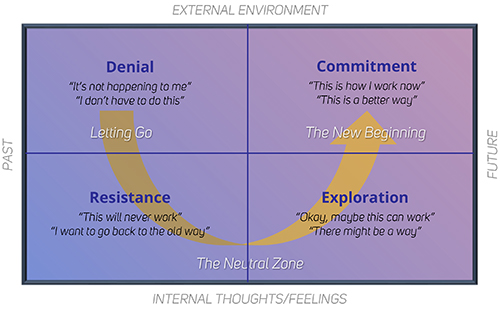 Change is Hard! Five Steps to Make it Easier
Change is Hard! Five Steps to Make it Easier
Jean Smithson-Bell, Smithson-Bell Consulting
As my father often said, it’s not the changes in life that cause us our stress or distress, but our reaction to the changes that will determine their outcome, positively or negatively. What he meant is that we must control our reactions to the many changes that impact our lives if we are to manage them well.
There are two types of changes that occur in the workplace: changes that individuals initiate and changes that are introduced by others. Typically, the changes we initiate ourselves are easier for us to digest than those introduced by others.
Here are the steps I practice, both professionally and personally, to help me manage change.
Step I
The best value set you can bring to the table is being positive, upbeat, and professional. No matter what the change happens to be — whether you initiated it or not, agree with it or not, like the players involved or not — demonstrating the values of honesty, integrity, trust, effective communication, and judgement can help you tackle the issues fairly, effectively, and with dignity. Your values are what make you who you are; bring your best values into the change process.
Step II
Corral your own emotional minefields before you start to deal with change. Perhaps a significant other, after a year and a half of dating, tells you they need to go it alone for a while, and you’re devastated; your best friend shares that she’s battling stage III breast cancer and she’d like your support and prayers now; or you’ve just learned that a colleague has been put in charge of a new program you saw yourself leading. You have to corral your emotions around disappointments, setbacks, and other bad news in all aspects of your life so that you’re able to be present for the workplace change that needs your attention now.
For steps one and two, mindful meditation practices are extremely helpful. Relaxation techniques, gentle yoga practices, taking a walk, or exercising are all wonderful ways to calm your spirit so that you are able to deal with whatever comes your way. Starting the change management process this way provides space for the brain to manage the change more effectively.
If you find that you’re unable to corral your emotions or feel overwhelmed by things in your personal or professional life, remember that free, confidential counseling and other services are offered through CareLink, the UW’s employee assistance program.
Step III
Understand the change curve. Elisabeth Kübler-Ross introduced this concept back in 1969 when she was helping people through stages of grief, and the concepts evolved to help those dealing generally with all kinds of change. The change curve helps with the people-skills portion of managing change by inspiring and motivating individuals to be “agents of change.”
The change model below indicates the four stages that we all go through whether it is a positive change or a negative change. The vertical axis at the top indicates factors that may occur in the external world, given the particular change. At the end of that axis are factors that may be occurring with the internal machinations of the person experiencing the change. The horizontal axis indicates moving from the past on the left to the future on the right as one moves through the change cycle. Note that with changes we introduce ourselves or changes introduced by others, happy or sad changes, expected or unexpected, we all migrate through the change cycle, some at faster rates than others.

Here are a few examples. Let’s say a company is going through a restructure or a layoff process and many of the employees have worked for the organization for a number of years. Naturally, many employees may be shocked by the news and wonder individually on the external horizontal axis, What is the job market like? Given my age and experience, will I be able to even get another job and how might I go about it? On the internal horizontal axis, they may be feeling not only sad and frightened about the job loss, but humiliated and embarrassed as well. They may have been planning to retire from that job or company, and wonder, How will I feed my family, pay my rent or mortgage, and show my face to my friends since my whole life has been tied to this job?
On the vertical axis, in the two quadrants on the left representing the past, the pleading of, This cannot be happening to me! kicks in along with bargaining to a higher power, I will do ANYTHING if you just reverse this decision in some way to save my job or position with this company! The language on the future side of the axis will sound more like, Well, I didn’t really like the job at all; it just paid the bills! and I still have a lot of years to live, maybe it really is time that I find something to do that I ACTUALLY enjoy! Maybe this can be a new and exciting opportunity for me to explore.
All of this occurs as the person is still moving through the four stages of the change curve (the yellow arrow) at their own pace. Rarely does a person move from Denial immediately over to Commitment. There is a flow, quickly or slowly and deliberately, through the change quadrants as we manage the change effectively. (The same process occurs with positive changes like planning a wonderful vacation or having a baby; all changes take you through the change process.)
Step IV
Understand the emotional ramifications that your staff may be experiencing. In order to lead them through a significant change, identify which quadrant of the change curve they are exhibiting so you can help move them from one quadrant to the next. This might be the single best thing you can do for your staff as you try to help them enthusiastically embrace the change that is needed or recognize when there is a difficulty getting in the way. Think about ways that you can develop opportunities for the staff to see change as a catalyst for innovation. When they buy in, amazing things happen.
You don’t have to go it alone. If you or your staff are struggling, note that UW CareLink provides free management consultations to help you maintain a positive work environment, as well as free one-hour trainings for your team on topics such as resiliency and communication. In addition, you may try talking the challenges over with your boss or another more seasoned manager to get a different perspective.
For any change that involves organizational restructuring, you are encouraged to partner with UWHR. Your HR consultant will assess the scope of the reorganization as well as staff impacts and procedural requirements. For particularly complex or high-impact changes, it may be worthwhile to invest in hiring a consultant with expertise in change management to help you and your team through the process.
Step V
Focus on alignment with the big picture. As a leader in an organization, your ability to align the change with the mission at hand will, in turn, demonstrate the vision and goals of the organization as well as the change’s logic. It’s a crucial step to get staff to join you in arranging for the realistic resources (e.g., time, funds, talent) available to enact the change.
When you agree with the change, adapting isn’t as hard. But when a change you don’t agree with is being implemented or required of you, ask yourself some questions:
- Are there any parts of the change that you can be in agreement with or where you can support the overall strategy of the change?
- If the “why” of the change is explained, might you be able to enlist more readily in the change processes being planned?
- Are there advocates you can enlist to help you navigate the change or hear your reticence and suggestions for why the change may need altering in order for its success to occur more readily?
Give the change a chance. Usually there are parts of the change that you will find you can live with and most times, after a year or two, something new will come along and the process will start all over again.
The bottom line is that change is inevitable. Managing our reactions is critical to success. I saw a pretty cool T-shirt once that I thought was perfect: “No matter the change, build a bridge and get over it! Breathe gently as you make it to the other side!”
A member of the University Consulting Alliance, Jean Smithson-Bell is a senior training and development professional and consultant with expertise in workforce productivity, coaching, strategic planning, and change management. You can reach Jean through the Alliance at alliance@uw.edu.


